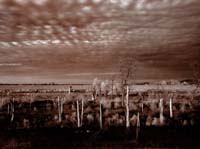
When I look at the countryside captured in D.’s photographs, I see a layered, deeply complicated, fraught landscape.
I continue to struggle to understand what has happened. D. and I argue over the kitchen table: Who is responsible? Who did what? What alternative paths were available?
D. fixes on the modernizing imagination, that envisioned a countryside made for a powerful urban elite’s aesthetic pleasure. I fix on the economic and political interests that drove post-WWII agricultural policy–the agro-industrial interests in the context of the U.S. industrial powerhouse. And the ways that farmers and other rural residents, themselves, participated, seemingly willingly, in their own demise.
There’s certainly enough blame to go around. This landscape, emptied of people, is neither the bucolic aesthetic vision of the urban agrarian, nor the "natural" landscape which people can only contemplate, envisioned by so many environmentalists, nor the economically vibrant multi-generational community envisioned by most farming people and rural residents–at least the propertied rural residents.
continued
I continue to struggle to understand what has happened. D. and I argue over the kitchen table: Who is responsible? Who did what? What alternative paths were available?
D. fixes on the modernizing imagination, that envisioned a countryside made for a powerful urban elite’s aesthetic pleasure. I fix on the economic and political interests that drove post-WWII agricultural policy–the agro-industrial interests in the context of the U.S. industrial powerhouse. And the ways that farmers and other rural residents, themselves, participated, seemingly willingly, in their own demise.
There’s certainly enough blame to go around. This landscape, emptied of people, is neither the bucolic aesthetic vision of the urban agrarian, nor the "natural" landscape which people can only contemplate, envisioned by so many environmentalists, nor the economically vibrant multi-generational community envisioned by most farming people and rural residents–at least the propertied rural residents.
continued

| PAGE |<< | 1 | 2 | 3 | 4 | 5 | 6 | 7 | 8 | 9 | 10 | | 11 | 12 | 13 | 14 | 15 | 16 | 17 | 18 | 19 | 20 | |
||
| D. Gorton's Home Page Jane Adams' Home Page Memory and Judgment: Mississippi The White South Contact Us |
|||||||||
|
This page was last modified on:
|
|||||||||